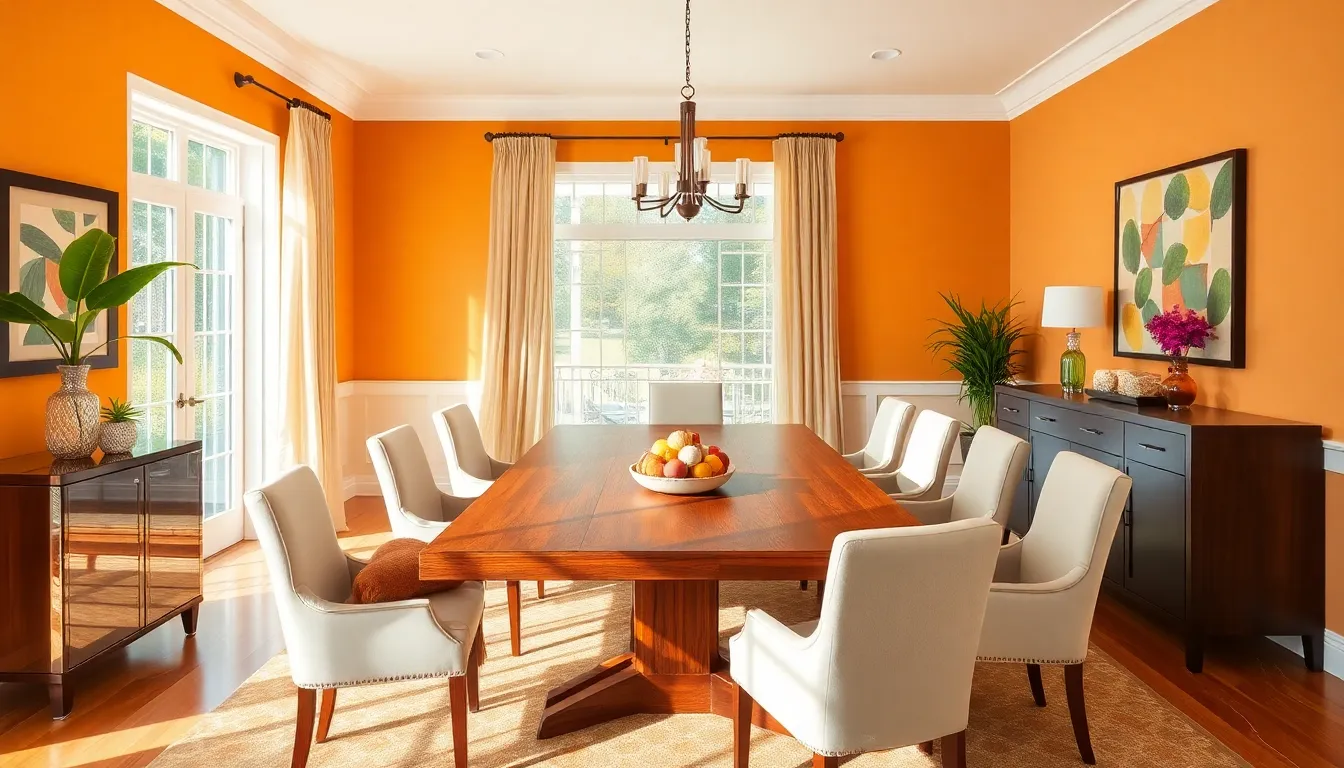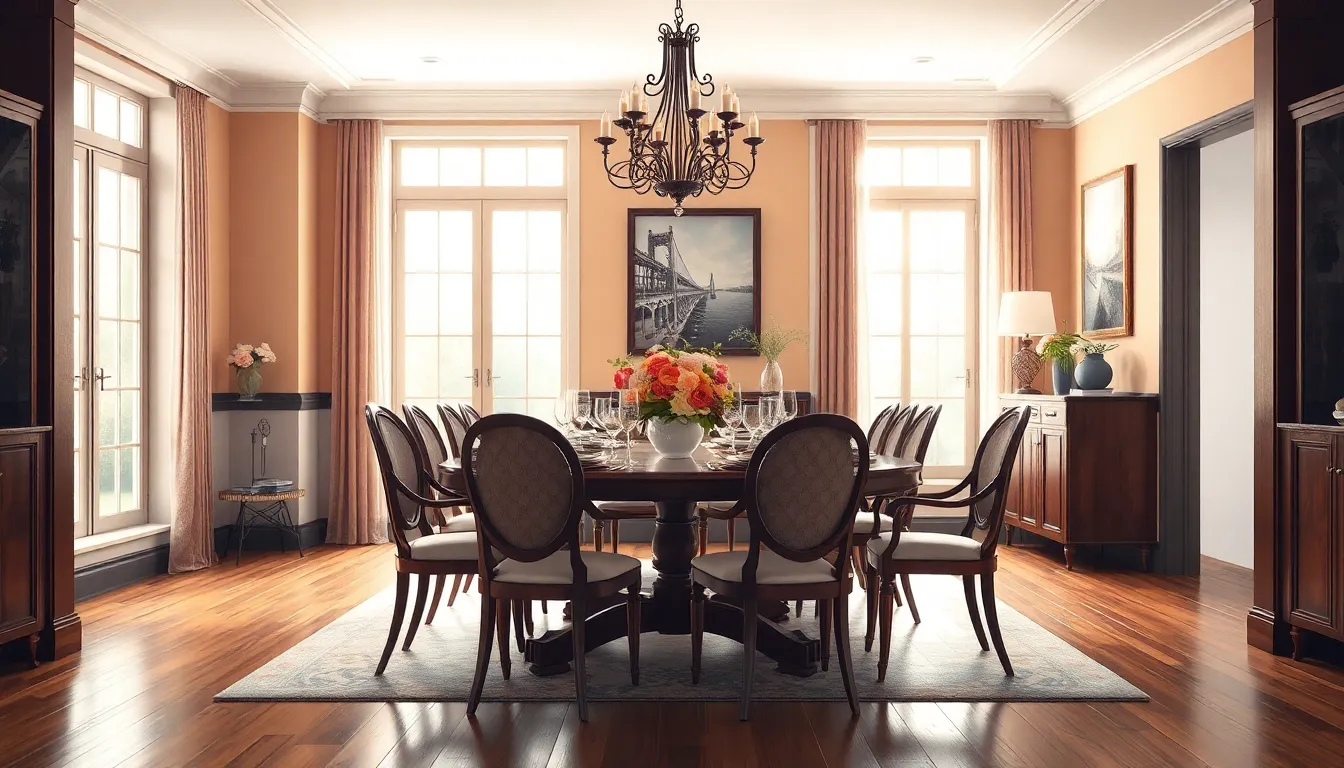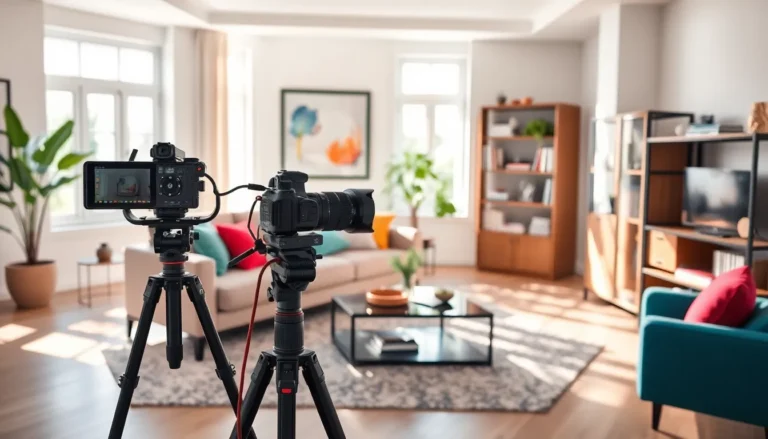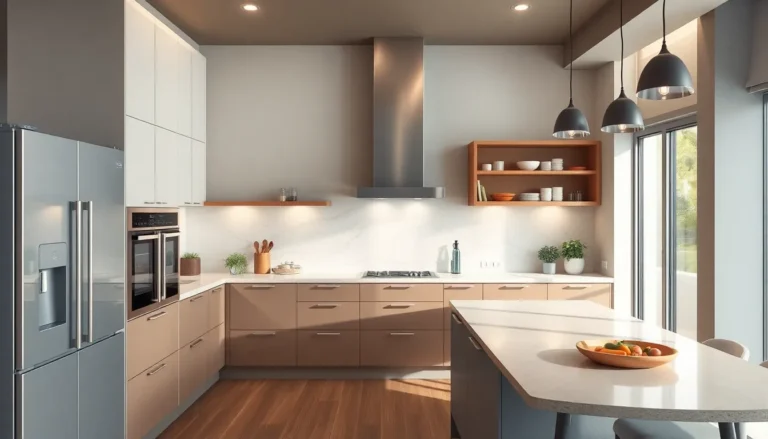The dining room is more than just a place to eat; it’s the heart of the home where memories are made, laughter echoes, and questionable culinary experiments take place. A well-designed dining room can elevate any meal from a mundane affair to a five-star dining experience—complete with a side of ambiance and a sprinkle of style.
Table of Contents
ToggleThe Importance of Dining Room Interior Design
Dining room interior design plays a crucial role in creating a welcoming atmosphere. A well-designed dining room fosters connection among family and friends, turning everyday meals into memorable gatherings. Significant transformations occur through the use of color, furniture, and decor. Thoughtful design elements enhance the overall aesthetic appeal, making the room inviting.
Functionality matters as well. Arranging seating for optimal movement allows for seamless dining experiences. Comfort should never be overlooked. Utilizing cushions and ergonomic chairs ensures guests remain relaxed throughout meals. Streamlined tables cater to varying group sizes, offering flexibility for social events.
Lighting also significantly impacts ambiance. Different styles like chandeliers or pendant lights create a unique atmosphere for every occasion. Natural light enhances the overall design while creating a bright, fresh space during the day. Positioning mirrors strategically can amplify light and make the room feel larger.
Artwork adds a personal touch to the dining room. Choosing pieces that resonate with the homeowner’s style enriches the overall vibe. Furthermore, incorporating plants introduces freshness and vitality to the space. These elements not only complement the design but also promote a sense of tranquility.
Ultimately, investing time and effort into dining room interior design pays off in the experiences shared within. It significantly influences the mood, enhancing moments spent around the table. Prioritizing design leads to cherished memories and deeper connections among loved ones.
Key Elements of Dining Room Design

Color, furniture, and decor significantly shape the dining room’s ambiance and functionality. These key elements work harmoniously to create an inviting and stylish space for memorable gatherings.
Color Schemes
Choosing a color scheme sets the mood in a dining room. Warm tones like reds and oranges energize the space, while cool shades such as blues and greens promote calmness. Neutral colors provide a versatile background that allows decor to shine. Consider incorporating accent walls or bold accessories to enhance visual interest. Patterns also add character—think stripes, florals, or geometric designs for table linens or curtains. A well-coordinated color palette ensures a cohesive look, enhancing the overall design appeal of the room.
Furniture Selection
Furniture selection impacts both aesthetics and functionality in the dining room. Opt for a dining table that fits your space and accommodates your needs—round tables work well for small areas, while rectangular tables suit larger gatherings. Choose comfortable chairs that complement the table’s style and encourage conversation. Materials matter; wood, metal, or upholstered options offer various looks and durability. Storage solutions like buffets or cabinets enhance organization and keep essentials accessible. Prioritizing multifunctional pieces maximizes space and contributes to a harmonious design.
Layout and Space Planning
Effective layout and space planning elevate the dining room’s functionality and aesthetic appeal. A well-oriented design fosters a natural flow, facilitating movement around the table and between chairs.
Optimizing Flow
Creating space for free movement enhances the dining experience. Identify high-traffic areas to prevent bottlenecks, ensuring guests navigate your dining room comfortably. Consider the overall atmosphere; open layouts often feel more welcoming. When choosing furniture, prioritize pieces that not only fit your style but also optimize space.
Dining Table Placement
Dining table placement significantly influences the room’s usability. Centering the table within the space creates symmetry and focal interest. Leave between 36 to 48 inches between the table edge and walls or furniture to accommodate movement. For larger gatherings, a rectangular table may serve better, while round options promote intimacy. Always consider natural light sources, as table placement near windows enhances dining ambiance.
Lighting Considerations
Lighting plays a critical role in dining room interior design, influencing both the atmosphere and functionality of the space. Thoughtful selection of lighting types enhances the overall experience during meals.
Ambient Lighting
Ambient lighting serves as the base illumination in the dining room. It ensures even light distribution while creating a warm environment. Overhead fixtures like chandeliers or pendant lights provide effective ambient lighting. Using dimmers allows for easy adjustments depending on the occasion, making the space adaptable. Natural light from windows also contributes significantly, enhancing the overall brightness during the day.
Accent Lighting
Accent lighting adds depth and highlights specific features within the dining room. This type of lighting draws attention to artwork or decor elements, showcasing their importance. Wall sconces or spotlights work well to create focal points around the room. Additionally, illuminated displays or decorative pendant lights can enhance visual interest. The strategic placement of accent lighting can elevate the ambiance, ensuring the dining experience remains inviting and aesthetically pleasing.
Personalizing Your Dining Room
Personalizing a dining room enhances the space’s character and reflects individual preferences. Thoughtful details create a unique atmosphere that resonates with family and friends.
Incorporating Art and Decor
Art complements the overall design, bringing vibrancy to the dining room. Select pieces that align with personal taste, such as paintings, sculptures, or prints. Adding decor items, like vases or table centerpieces, introduces texture and visual interest. Opt for cohesive colors to unify the space. Incorporating elements like framed photographs personalizes the area further, evoking cherished memories. Layering textures through fabrics in table linens or wall hangings introduces warmth, making the area inviting.
Thematic Design Ideas
Thematic design can add a distinct flair to the dining room. Coastal themes utilize ocean-inspired colors and materials, evoking a serene atmosphere. Rustic designs embrace natural wood elements, enhancing a warm, homey feel. Modern aesthetics focus on minimalism, incorporating sleek lines and bold colors. Vintage influences can be captured through retro furnishings and nostalgic colors. Transitioning between these themes allows for creativity and expression. Enabling a seamless flow between dining and living areas enhances the overall coherence of the home’s design.
A well-designed dining room is more than just a space for meals; it’s where connections are nurtured and memories are made. By carefully considering elements like color, furniture, and lighting, anyone can create an inviting atmosphere that enhances every dining experience.
Personal touches through decor and artwork can further elevate the room’s character, making it a true reflection of individual style. With thoughtful layout and functional design, the dining room can seamlessly blend aesthetics with practicality. Investing time and effort into this space ultimately enriches the moments shared with family and friends, transforming ordinary gatherings into extraordinary ones.




